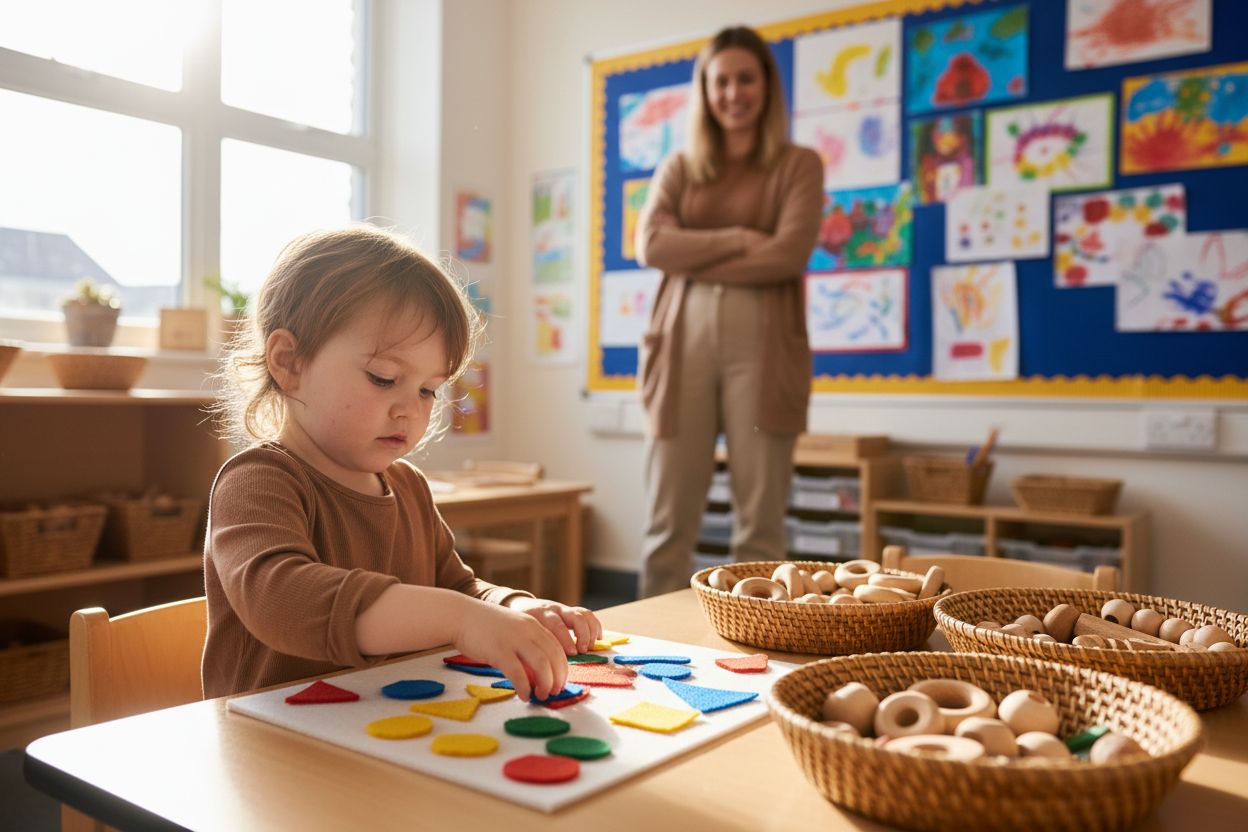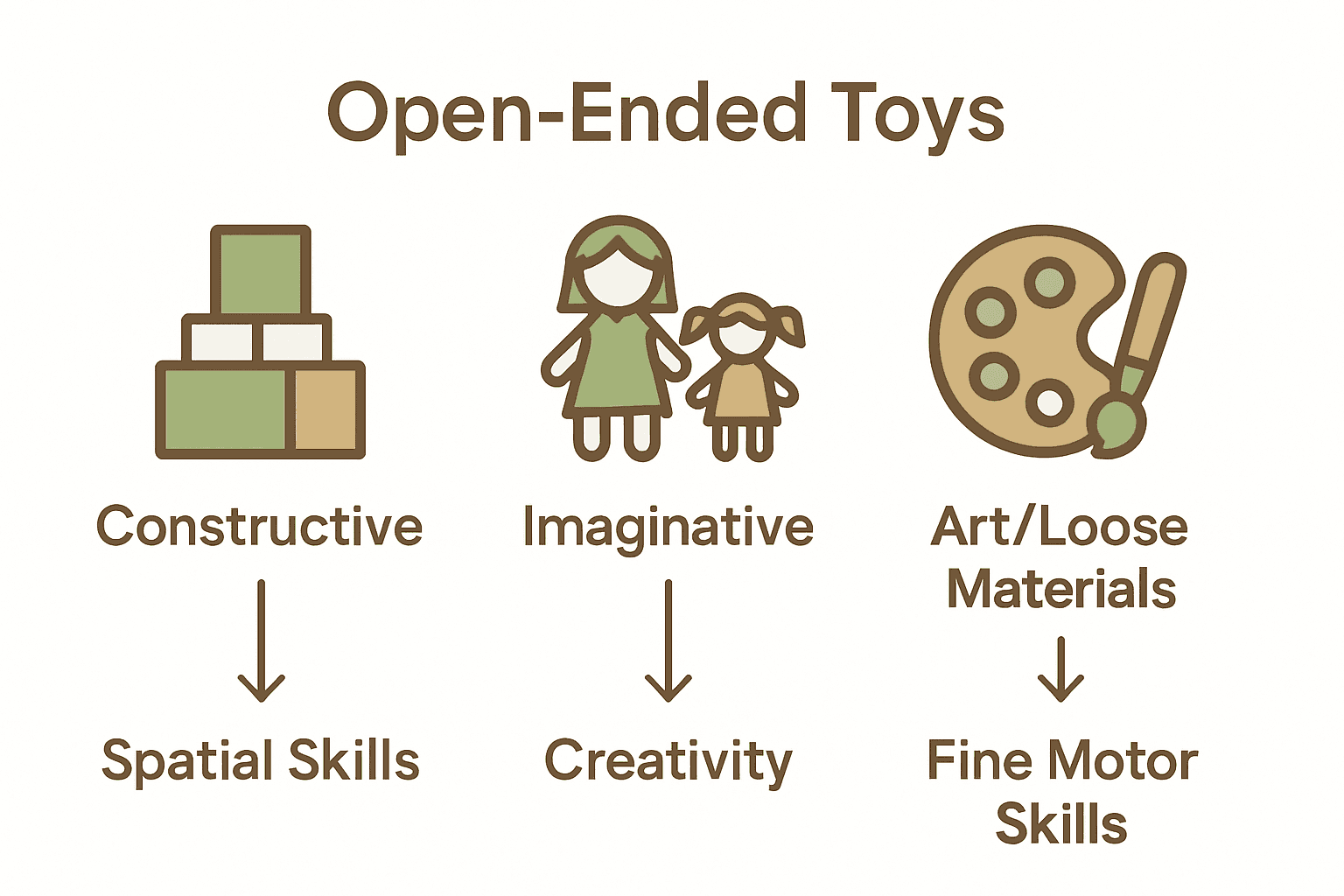Did you know that children engaged in open-ended play show higher levels of creativity and problem-solving skills compared to those with structured toys? Many parents still believe open-ended toys must be fancy or expensive, but even simple objects can inspire powerful learning. Understanding the real value of these toys helps families nurture independent thinking, fuel imagination, and support development with play that evolves as a child grows.
Key Takeaways
| Point | Details |
|---|---|
| Open-Ended Toys Foster Creativity | These toys encourage children to explore, create, and problem-solve without predetermined outcomes. |
| Supports Developmental Skills | Open-ended toys enhance cognitive, social-emotional, and motor skills across various age stages. |
| Simple Yet Powerful | Common items like blocks or art supplies can serve as effective open-ended toys, promoting imaginative play. |
| Prioritize Safety in Selection | It’s crucial to choose toys that meet UK safety regulations for the best balance of quality and developmental value. |
Table of Contents
- Defining Open Ended Toys And Common Myths
- Types Of Open Ended Toys For Children
- How Open Ended Toys Support Development
- Creativity, Imagination, And Lifelong Skills
- Choosing Safe And High-Quality Toys In The UK
Defining Open Ended Toys and Common Myths
When we talk about open-ended toys, we’re exploring a world of play that goes far beyond traditional, prescriptive playthings. Unlike toys with fixed outcomes, open-ended toys invite children to imagine, create, and explore without predetermined boundaries. Explore our complete guide to open-ended toys to understand this transformative play approach.
According to research from UK parenting experts, open-ended play is fundamentally about giving children the freedom to make their own decisions and express their unique intelligence. These toys support independent play and stimulate crucial developmental skills across various age stages. Typical characteristics include:
- No predetermined goals or instructions
- Multiple ways of interaction
- Encourages creativity and problem-solving
- Adaptable across different developmental stages
Common myths about open-ended toys often suggest they’re complex or expensive. In reality, they can be incredibly simple – wooden blocks, art supplies, or even household objects can become powerful tools for imaginative exploration. The key is allowing children to lead their play, transforming everyday items into magical worlds of their own making. By removing strict guidelines, we give children the incredible gift of unstructured creativity and self-directed learning.
Types of Open Ended Toys for Children
Open-ended toys come in delightful varieties that spark imagination and encourage creative play. Discover our wooden toy selection to explore versatile play options that grow with your child. According to research, some of the most engaging open-ended toys include:
Constructive Toys:
- Wooden blocks
- Building sets
- Magnetic tiles
- Interlocking bricks
Imaginative Play Items:
- Felt toys
- Wooden peg dolls
- Play silks
- Loose parts like wooden rings
Take the classic Fuzzy-Felt, a quintessential UK toy that brilliantly demonstrates open-ended play principles. Children aged 3 and above can repeatedly create unique scenes by arranging felt shapes, showcasing how simple materials can transform into endless storytelling opportunities.
 This toy has demonstrated remarkable durability across generations, proving that open-ended toys aren’t just playthings – they’re experiences that evolve with a child’s growing creativity.
This toy has demonstrated remarkable durability across generations, proving that open-ended toys aren’t just playthings – they’re experiences that evolve with a child’s growing creativity.
Beyond specific toy types, the magic of open-ended play lies in providing children with versatile tools that encourage exploration. Whether it’s art supplies, natural materials like stones and sticks, or simple household objects, the best open-ended toys don’t dictate play – they invite imagination. They allow children to be architects of their own play worlds, developing critical thinking, problem-solving skills, and boundless creativity in the process.
Here’s a comparison of common types of open-ended toys and their developmental benefits:

| Toy Type | Example Toys | Key Skills Supported |
|---|---|---|
| Constructive | Wooden blocks Building sets Magnetic tiles |
Spatial awareness Logical thinking |
| Imaginative Play | Felt toys Play silks Wooden peg dolls |
Creativity Storytelling |
| Art & Loose Materials | Art supplies Household objects Natural elements |
Fine motor skills Problem-solving |
| Multi-Age Adaptable | Fuzzy-Felt Loose parts Linking cubes |
Social skills Independent play |
How Open Ended Toys Support Development
Open-ended toys are far more than simple playthings – they’re powerful developmental tools that nurture children’s growth across multiple domains. Learn more about our creative toy approaches to understand their transformative potential.
According to research, these versatile toys significantly enhance cognitive development through unstructured play. They stimulate essential skills such as:
- Spatial Awareness: Understanding physical relationships
- Logical Thinking: Developing problem-solving strategies
- Engineering Concepts: Exploring structural design
- Geometric Understanding: Recognizing shapes and patterns
Beyond cognitive development, open-ended toys play a crucial role in social-emotional learning. Unstructured play creates safe spaces for children to express feelings, negotiate roles, and develop collaborative skills. Through self-narration and imaginative storytelling, children practice language skills while building emotional intelligence.
Specific toys like linking cubes and building sets support fine and gross motor skills development. Children enhance hand-eye coordination, dexterity, balance, and spatial awareness through natural, playful interactions. The beauty of open-ended toys lies in their ability to grow with the child, offering increasingly complex play opportunities that adapt to developing cognitive and physical capabilities.
Creativity, Imagination, and Lifelong Skills
Imagination is the cornerstone of childhood development, and open-ended toys are the perfect catalyst for nurturing this critical skill. Explore our guide to educational toys to understand how play transforms learning.
Research reveals that open-ended play supports creativity by encouraging children to devise solutions independently. Key benefits include:
- Emotional Intelligence: Processing real-life situations through pretend play
- Social Skills: Developing cooperative interaction abilities
- Independence: Building confidence through child-led decision making
- Problem-Solving: Creating unique approaches to play challenges
Pretend play scenarios become powerful learning experiences where children explore complex emotional landscapes. A child might transform wooden blocks into a castle, a spaceship, or a hospital – each scenario allowing them to experiment with roles, emotions, and social dynamics. This process isn’t just play; it’s a sophisticated form of learning that prepares children for real-world interactions.
Moreover, open-ended toys offer a crucial non-digital alternative in our screen-dominated world. By encouraging active, imaginative play, these toys help children develop lifelong skills of creativity, adaptability, and independent thinking. They teach children that there are multiple ways to approach a challenge, a lesson far more valuable than any predetermined play pattern.
Choosing Safe and High-Quality Toys in the UK
When selecting open-ended toys for your child, safety and quality are paramount. Discover our first birthday toy guide to understand age-appropriate selections that prioritise child development and safety.
According to UK safety regulations, parents should look for specific safety markers when purchasing toys:
- CE Mark: European Conformity certification
- UKCA Mark: UK Conformity Assessed standard
- Lion Mark: Voluntary quality indicator for British-made toys
The UK Government’s Department for Business and Trade enforces stringent EN 71 toy safety standards, which cover critical safety aspects including:
- Mechanical safety
- Chemical composition
- Flammability requirements
- Appropriate labelling
Beyond official certifications, parents should regularly inspect toys for potential hazards such as small detachable parts, loose materials, or signs of wear. Open-ended toys from reputable suppliers offer not just safety, but also developmental value. By choosing toys that meet rigorous UK standards, you’re investing in your child’s safe, imaginative play experience – ensuring that creativity and safety go hand in hand.
Spark Meaningful Play and Unlock Your Child’s Potential
Worried your child’s toys limit their creativity and growth? The article has shown just how powerful open ended toys can be for problem-solving, imagination and lifelong learning. Yet, many parents struggle to find safe, high-quality options that truly support these essential skills. At Learning Bugs, we offer a carefully selected range of timeless toys designed to match every developmental stage and family need.

Choose toys that grow with your child, nurture independent thinking and make every play session a chance for discovery. Visit Learning Bugs now and explore our collection of wooden toys and educational gifts inspired by the very principles discussed here. Start your journey to more joyful, meaningful play today before those special moments pass.
Frequently Asked Questions
What are open-ended toys?
Open-ended toys are playthings that encourage creativity and imagination without predetermined goals or instructions. They allow children to explore and create freely, transforming simple materials into rich play experiences.
How do open-ended toys support child development?
Open-ended toys support child development by enhancing cognitive, social-emotional, and physical skills. They stimulate creativity, problem-solving, spatial awareness, and collaboration, all of which are essential for a child’s growth.
What types of open-ended toys are recommended for children?
Recommended types of open-ended toys include constructive toys like wooden blocks and building sets, imaginative play items like felt toys and peg dolls, and art materials or loose parts. These toys cater to varying developmental stages and encourage versatile play.
Why are open-ended toys considered safer than traditional toys?
Open-ended toys are often made from high-quality materials and designed to meet strict safety standards. They usually contain fewer small parts and less complex mechanical features, reducing the risk of hazards associated with traditional toys.

0 comments